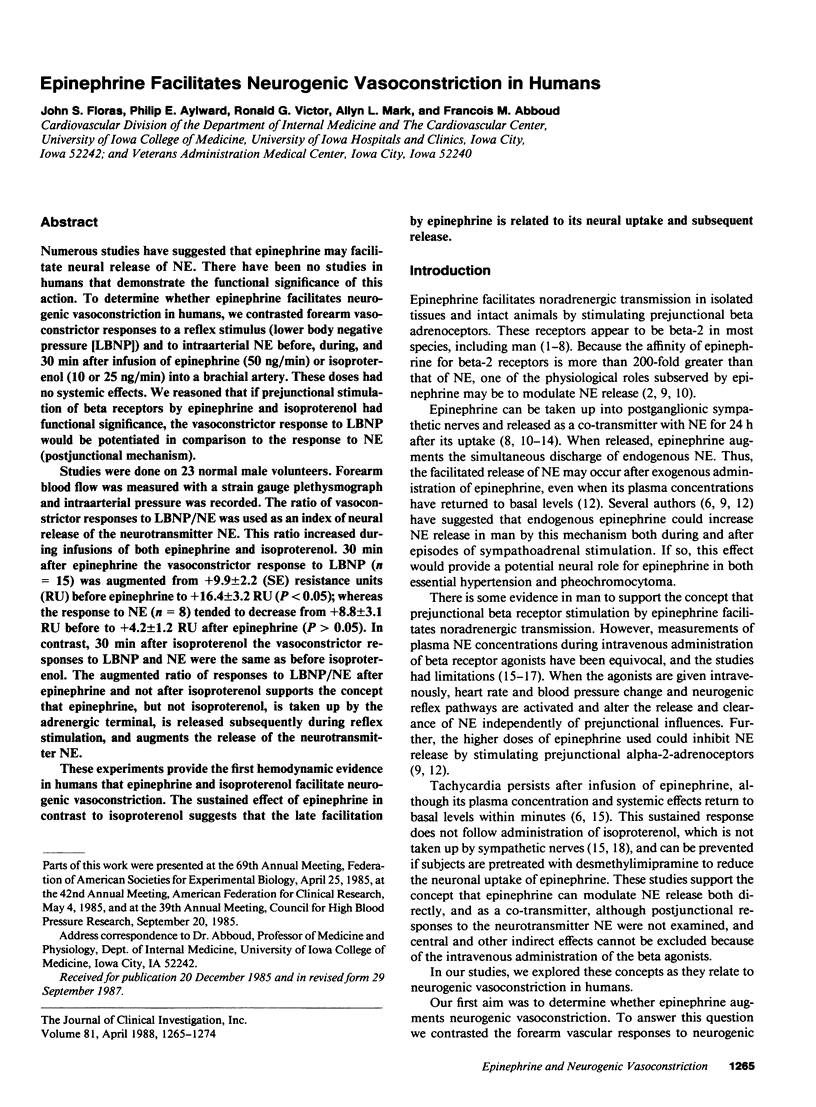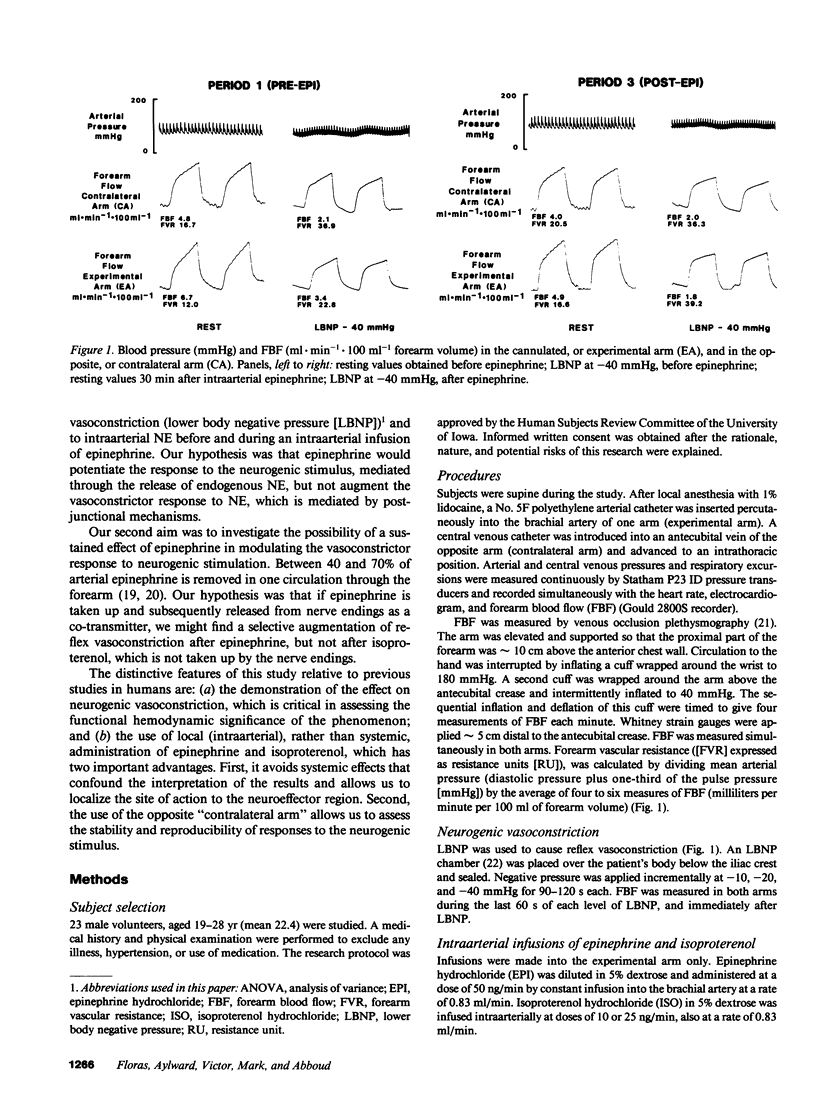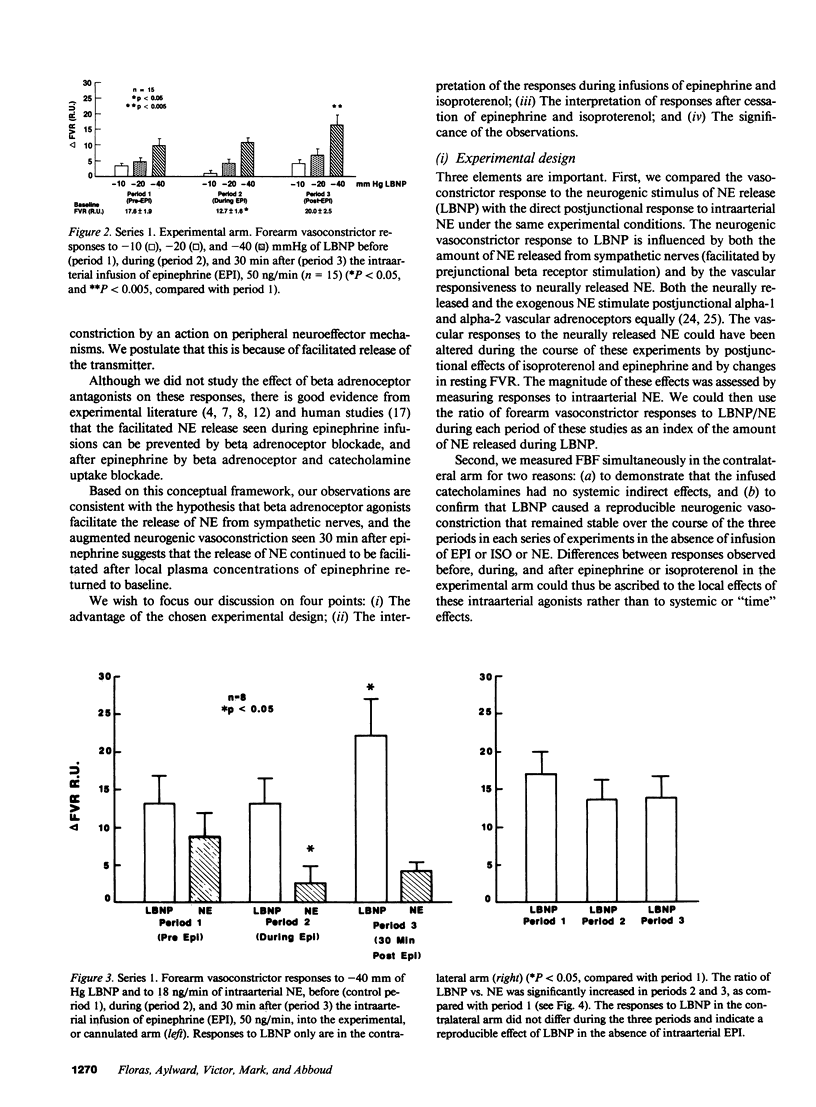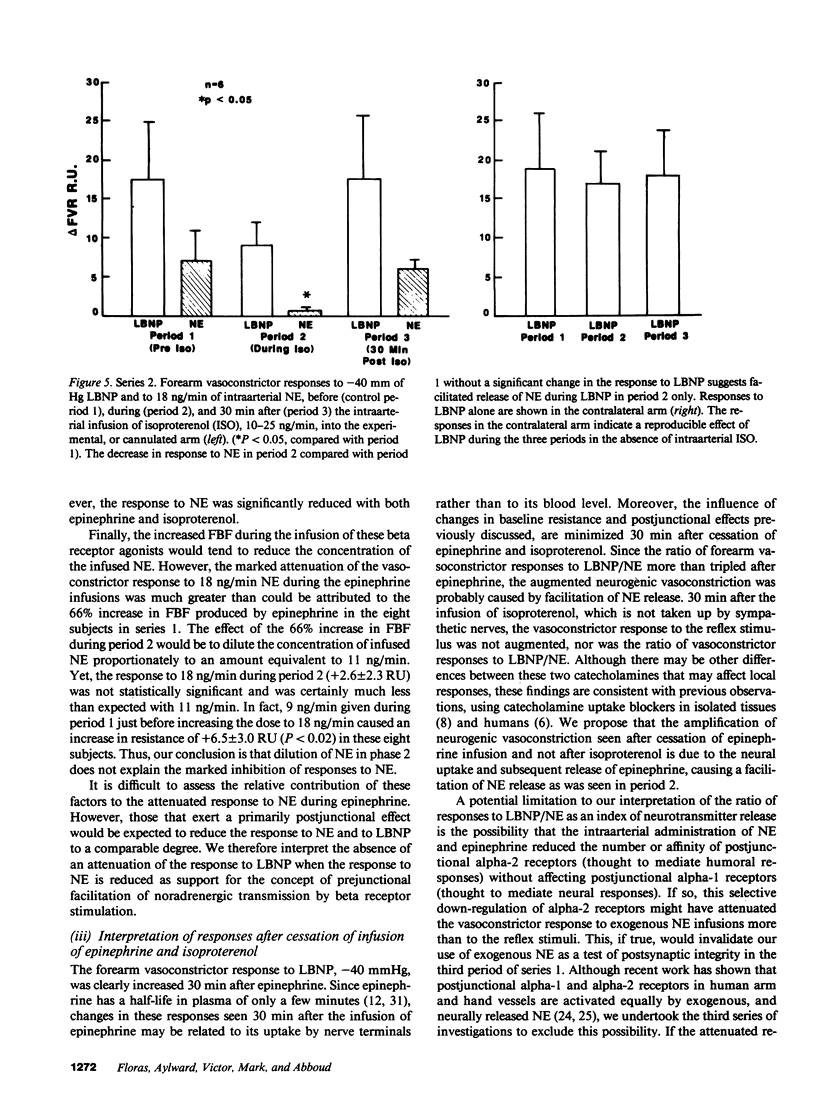Abstract
Numerous studies have suggested that epinephrine may facilitate neural release of NE. There have been no studies in humans that demonstrate the functional significance of this action. To determine whether epinephrine facilitates neurogenic vasoconstriction in humans, we contrasted forearm vasoconstrictor responses to a reflex stimulus (lower body negative pressure [LBNP]) and to intraarterial NE before, during, and 30 min after infusion of epinephrine (50 ng/min) or isoproterenol (10 or 25 ng/min) into a brachial artery. These doses had no systemic effects. We reasoned that if prejunctional stimulation of beta receptors by epinephrine and isoproterenol had functional significance, the vasoconstrictor response to LBNP would be potentiated in comparison to the response to NE (postjunctional mechanism). Studies were done on 23 normal male volunteers. Forearm blood flow was measured with a strain gauge plethysmograph and intraarterial pressure was recorded. The ratio of vasoconstrictor responses to LBNP/NE was used as an index of neural release of the neurotransmitter NE. This ratio increased during infusions of both epinephrine and isoproterenol. 30 min after epinephrine the vasoconstrictor response to LBNP (n = 15) was augmented from +9.9 +/- 2.2 (SE) resistance units (RU) before epinephrine to +16.4 +/- 3.2 RU (P less than 0.05); whereas the response to NE (n = 8) tended to decrease from +8.8 +/- 3.1 RU before to +4.2 +/- 1.2 RU after epinephrine (P greater than 0.05). In contrast, 30 min after isoproterenol the vasoconstrictor responses to LBNP and NE were the same as before isoproterenol. The augmented ratio of responses to LBNP/NE after epinephrine and not after isoproterenol supports the concept that epinephrine, but not isoproterenol, is taken up by the adrenergic terminal, is released subsequently during reflex stimulation, and augments the release of the neurotransmitter NE. These experiments provide the first hemodynamic evidence in humans that epinephrine and isoproterenol facilitate neurogenic vasoconstriction. The sustained effect of epinephrine in contrast to isoproterenol suggests that the late facilitation by epinephrine is related to its neural uptake and subsequent release.
Full text
PDF









Selected References
These references are in PubMed. This may not be the complete list of references from this article.
- Abboud F. M., Schmid P. G., Eckstein J. W. Vascular responses after alpha adrenergic receptor blockade: I. Responses of capacitance and resistance vessels to norepinephrine in man. J Clin Invest. 1968 Jan;47(1):1–9. doi: 10.1172/JCI105699. [DOI] [PMC free article] [PubMed] [Google Scholar]
- Adler-Graschinsky E., Langer S. Z. Possible role of a beta-adrenoceptor in the regulation of noradrenaline release by nerve stimulation through a positive feed-back mechanism. Br J Pharmacol. 1975 Jan;53(1):43–50. doi: 10.1111/j.1476-5381.1975.tb07328.x. [DOI] [PMC free article] [PubMed] [Google Scholar]
- Berecek K. H., Brody M. J. Evidence for a neurotransmitter role for epinephrine derived from the adrenal medulla. Am J Physiol. 1982 Apr;242(4):H593–H601. doi: 10.1152/ajpheart.1982.242.4.H593. [DOI] [PubMed] [Google Scholar]
- Bravo E. L., Tarazi R. C., Fouad F. M., Vidt D. G., Gifford R. W., Jr Clonidine-suppression test: a useful aid in the diagnosis of pheochromocytoma. N Engl J Med. 1981 Sep 10;305(11):623–626. doi: 10.1056/NEJM198109103051107. [DOI] [PubMed] [Google Scholar]
- Brodde O. E., Prywarra A., Daul A., Anlauf M., Bock K. D. Correlation between lymphocyte beta 2-adrenoceptor density and mean arterial blood pressure: elevated beta-adrenoceptors in essential hypertension. J Cardiovasc Pharmacol. 1984 Jul-Aug;6(4):678–682. doi: 10.1097/00005344-198407000-00020. [DOI] [PubMed] [Google Scholar]
- Brown M. J., Brown D. C., Murphy M. B. Hypokalemia from beta2-receptor stimulation by circulating epinephrine. N Engl J Med. 1983 Dec 8;309(23):1414–1419. doi: 10.1056/NEJM198312083092303. [DOI] [PubMed] [Google Scholar]
- Brown M. J., Dollery C. T. Adrenaline and hypertension. Clin Exp Hypertens A. 1984;6(1-2):539–549. doi: 10.3109/10641968409062582. [DOI] [PubMed] [Google Scholar]
- Brown M. J., Macquin I. Is adrenaline the cause of essential hypertension? Lancet. 1981 Nov 14;2(8255):1079–1082. doi: 10.1016/s0140-6736(81)91279-4. [DOI] [PubMed] [Google Scholar]
- Dahlöf C. Studies on beta-adrenoceptor mediated facilitation of sympathetic neurotransmission. Acta Physiol Scand Suppl. 1981;500:1–147. [PubMed] [Google Scholar]
- ECKSTEIN J. W., WENDLING M. G., ABBOUD F. M. FOREARM VENOUS RESPONSES TO STIMULATION OF ADRENERGIC RECEPTORS. J Clin Invest. 1965 Jul;44:1151–1159. doi: 10.1172/JCI105222. [DOI] [PMC free article] [PubMed] [Google Scholar]
- Ferreira S. H., Vane J. R. Half-lives of peptides and amines in the circulation. Nature. 1967 Sep 16;215(5107):1237–1240. doi: 10.1038/2151237a0. [DOI] [PubMed] [Google Scholar]
- GREENFIELD A. D., WHITNEY R. J., MOWBRAY J. F. Methods for the investigation of peripheral blood flow. Br Med Bull. 1963 May;19:101–109. doi: 10.1093/oxfordjournals.bmb.a070026. [DOI] [PubMed] [Google Scholar]
- GREEN H. D., KEPCHAR J. H. Control of peripheral resistance in major systemic vascular beds. Physiol Rev. 1959 Jul;39(3):617–686. doi: 10.1152/physrev.1959.39.3.617. [DOI] [PubMed] [Google Scholar]
- Goldstein D. S. Plasma catecholamines and essential hypertension. An analytical review. Hypertension. 1983 Jan-Feb;5(1):86–99. doi: 10.1161/01.hyp.5.1.86. [DOI] [PubMed] [Google Scholar]
- Halter J. B., Pflug A. E., Tolas A. G. Arterial-venous differences of plasma catecholamines in man. Metabolism. 1980 Jan;29(1):9–12. doi: 10.1016/0026-0495(80)90090-6. [DOI] [PubMed] [Google Scholar]
- Iversen L. L. Catecholamine uptake processes. Br Med Bull. 1973 May;29(2):130–135. doi: 10.1093/oxfordjournals.bmb.a070982. [DOI] [PubMed] [Google Scholar]
- Johnson M. D., Grignolo A., Kuhn C. M., Schanberg S. M. Hypertension and cardiovascular hypertrophy during chronic catecholamine infusion in rats. Life Sci. 1983 Jul 11;33(2):169–180. doi: 10.1016/0024-3205(83)90410-1. [DOI] [PubMed] [Google Scholar]
- Majewski H., McCulloch M. W., Rand M. J., Story D. F. Adrenaline activation of prejunctional beta-adrenoceptors in guinea-pig atria. Br J Pharmacol. 1980;71(2):435–444. doi: 10.1111/j.1476-5381.1980.tb10956.x. [DOI] [PMC free article] [PubMed] [Google Scholar]
- Majewski H. Modulation of noradrenaline release through activation of presynaptic beta-adrenoreceptors. J Auton Pharmacol. 1983 Mar;3(1):47–60. doi: 10.1111/j.1474-8673.1983.tb00496.x. [DOI] [PubMed] [Google Scholar]
- Majewski H., Rand M. J., Tung L. H. Activation of prejunctional beta-adrenoceptors in rat atria by adrenaline applied exogenously or released as a co-transmitter. Br J Pharmacol. 1981 Jul;73(3):669–679. doi: 10.1111/j.1476-5381.1981.tb16802.x. [DOI] [PMC free article] [PubMed] [Google Scholar]
- Majewski H., Tung L. H., Rand M. J. Adrenaline activation of prejunctional beta-adrenoceptors and hypertension. J Cardiovasc Pharmacol. 1982 Jan-Feb;4(1):99–106. doi: 10.1097/00005344-198201000-00016. [DOI] [PubMed] [Google Scholar]
- Nezu M., Miura Y., Adachi M., Adachi M., Kimura S., Toriyabe S., Ishizuka Y., Ohashi H., Sugawara T., Takahashi M. The effects of epinephrine on norepinephrine release in essential hypertension. Hypertension. 1985 Mar-Apr;7(2):187–195. doi: 10.1161/01.hyp.7.2.187. [DOI] [PubMed] [Google Scholar]
- Quinn P., Borkowski K. R., Collis M. G. Epinephrine enhances neurogenic vasoconstriction in the rat perfused kidney. Hypertension. 1985 Jan-Feb;7(1):47–52. doi: 10.1161/01.hyp.7.1.47. [DOI] [PubMed] [Google Scholar]
- ROSELL S., AXELROD J., KOPIN I. J. RELEASE OF TRITIATED EPINEPHRINE FOLLOWING SYMPATHETIC NERVE STIMULATION. Nature. 1964 Jan 18;201:301–301. doi: 10.1038/201301a0. [DOI] [PubMed] [Google Scholar]
- Schmidt H. H., Schurr C., Hedler L., Majewski H. Local modulation of noradrenaline release in vivo: presynaptic beta 2-adrenoceptors and endogenous adrenaline. J Cardiovasc Pharmacol. 1984 Jul-Aug;6(4):641–649. doi: 10.1097/00005344-198407000-00014. [DOI] [PubMed] [Google Scholar]
- Stevens M. J., Moulds R. F. Neuronally released norepinephrine does not preferentially activate postjunctional alpha 1-adrenoceptors in human blood vessels in vitro. Circ Res. 1985 Sep;57(3):399–405. doi: 10.1161/01.res.57.3.399. [DOI] [PubMed] [Google Scholar]
- Stj-5aarne L., Brundin J. Dual adreoceptor-mediated control of noradrenaline secretion from human vasoconstrictor nerves: facilitation by BETA-receptors and inhibitor by alpha-receptors. Acta Physiol Scand. 1975 May;94(1):139–141. doi: 10.1111/j.1748-1716.1975.tb05872.x. [DOI] [PubMed] [Google Scholar]
- Stjärne L., Brundin J. Beta2-adrenoceptors facilitating noradrenaline secretion from human vasoconstrictor nerves. Acta Physiol Scand. 1976 Mar;97(1):88–93. doi: 10.1111/j.1748-1716.1976.tb10238.x. [DOI] [PubMed] [Google Scholar]
- Tohmeh J. F., Cryer P. E. Biphasic adrenergic modulation of beta-adrenergic receptors in man. Agonist-induced early increment and late decrement in beta-adrenergic receptor number. J Clin Invest. 1980 Apr;65(4):836–840. doi: 10.1172/JCI109735. [DOI] [PMC free article] [PubMed] [Google Scholar]
- Tung L. H., Rand M. J., Majewski H. Adrenaline-induced hypertension in rats. Clin Sci (Lond) 1981 Dec;61 (Suppl 7):191s–193s. doi: 10.1042/cs061191s. [DOI] [PubMed] [Google Scholar]
- VENDSALU A. Studies on adrenaline and noradrenaline in human plasma. Acta Physiol Scand Suppl. 1960;49(173):1–123. [PubMed] [Google Scholar]
- Verbeuren T. J., Lorenz R. R., Aarhus L. L., Shepherd J. T., Vanhoutte P. M. Prejunctional beta-adrenoceptors in human and canine saphenous veins. J Auton Nerv Syst. 1983 Jul;8(3):261–271. doi: 10.1016/0165-1838(83)90109-1. [DOI] [PubMed] [Google Scholar]
- Vincent H. H., Boomsma F., Man in't Veld A. J., Derkx F. H., Wenting G. J., Schalekamp M. A. Effects of selective and nonselective beta-agonists on plasma potassium and norepinephrine. J Cardiovasc Pharmacol. 1984 Jan-Feb;6(1):107–114. [PubMed] [Google Scholar]
- Zabludowski J., Clark S., Ball S. G., Brown A. J., Inglis G. C., Lever A. F., Murray G. Pressor effects of brief and prolonged infusions of epinephrine in the conscious rat. Am J Physiol. 1984 May;246(5 Pt 2):H683–H689. doi: 10.1152/ajpheart.1984.246.5.H683. [DOI] [PubMed] [Google Scholar]
- Zoller R. P., Mark A. L., Abboud F. M., Schmid P. G., Heistad D. D. The role of low pressure baroreceptors in reflex vasoconstrictor responses in man. J Clin Invest. 1972 Nov;51(11):2967–2972. doi: 10.1172/JCI107121. [DOI] [PMC free article] [PubMed] [Google Scholar]


